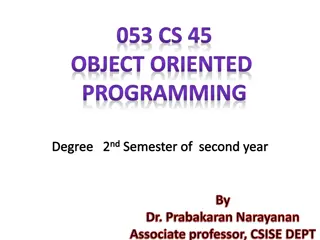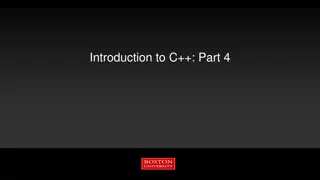Understanding C++ Templates: Generic Programming and Function Templates
Exploring the concepts of C++ templates including type-independent patterns for working with various data types, generic class patterns, function templates, and their usage. The reading covers examples of function templates for finding maximum values in vectors and highlights the importance of clearly defining assumptions. It also delves into class templates, operator overloading, and comparison methods in C++. Additionally, function objects and their usage in defining custom functions for specific data types are discussed.
Download Presentation

Please find below an Image/Link to download the presentation.
The content on the website is provided AS IS for your information and personal use only. It may not be sold, licensed, or shared on other websites without obtaining consent from the author. Download presentation by click this link. If you encounter any issues during the download, it is possible that the publisher has removed the file from their server.
E N D
Presentation Transcript
Chapter 1 C++ Templates Readings: Sections 1.6 and 1.7 1
Templates Type-independent patterns that can work with multiple data types. Generic programming Code reusable Function Templates These define logic behind the algorithms that work for multiple data types. Class Templates These define generic class patterns into which specific data types can be plugged in to produce new classes. 2
Function Templates Example Generic function to find a maximum value in a given vector If argument is a vector<int> type, then compiler generates a corresponding function where Comparable is replaced by int type. Similarly for vector<double>, vector<string> etc. Assumption in this example: Operator < is defined in the Comparable. Hence assumptions made by the template must be clearly stated. template <class Comparable> 3
Function Templates Usage Each call to findMax() on a different data type forces the compiler to generate a different function using the template. Compiler will complain about findMax(v4) because IntCell class does not defined operator< 4
An example class Square { public: explicit Square( double s = 0.0 ) : side{ s } { } double getSide( ) const { return side; } double getArea( ) const { return side * side; } double getPerimeter( ) const { return 4 * side; } Operator Overloading Comparison operator< Defines the meaning of operator< for Employee class. Output operator<< Define a global nonclass function operator<< that calls print( ) Define a public member function print( ostream & out) void print( ostream & out = cout ) const { out << "(square " << getSide( ) << ")"; } bool operator< ( const Square & rhs ) const { return getSide( ) < rhs.getSide( ); } private: double side; }; // Define an output operator for Square ostream & operator<< ( ostream & out, const Square & rhs ) { rhs.print( out ); return out; } 5
Function Objects template <typename Object, typename Comparator> const Object & findMax( const vector<Object> & arr, Comparator cmp ) { int maxIndex = 0; Objects whose primary purpose is to define a function for( int i = 1; i < arr.size( ); ++i ) if( cmp.isLessThan( arr[ maxIndex ], arr[ i ] ) ) maxIndex = i; Here findMax accepts a Comparator parameter as a function object. Comparator assumed to define the isLessThan( ) function. return arr[ maxIndex ]; } class CaseInsensitiveCompare { public: bool isLessThan( const string & lhs, const string & rhs ) const { return strcasecmp( lhs.c_str( ), rhs.c_str( ) ) < 0; } }; There is a more formal way to define function objects in C++ (next slide). int main( ) { vector<string> arr = { "ZEBRA", "alligator", "crocodile" }; cout << findMax( arr, CaseInsensitiveCompare{ } ) << endl; return 0; } 6
Function objects in C++ style template <typename Object, typename Comparator> const Object & findMax( const vector<Object> & arr, { int maxIndex = 0; Comparator isLessThan ) for( int i = 1; i < arr.size( ); ++i ) if( isLessThan( arr[ maxIndex ], arr[ i ] ) ) maxIndex = i; Using operator overloading Define operator () for CaseInsensitiveCompare class Instead of cmp.operator()(x,y) we can use cmp(x,y) return arr[ maxIndex ]; } const Object & findMax( const vector<Object> & arr ) { return findMax( arr, less<Object>{ } ); } class CaseInsensitiveCompare { public: bool operator( )( const string & lhs, const string & rhs ) const { return strcasecmp( lhs.c_str( ), rhs.c_str( ) ) < 0; } }; Case-sensitive comparison can also be performed using STL function object less<Object>(...) int main( ) { vector<string> arr = { "ZEBRA", "alligator", "crocodile" }; cout << findMax( arr, CaseInsensitiveCompare{ } ) << endl; cout << findMax( arr ) << endl; return 0; } 7
Class Template Example /** * A class for simulating a memory cell. */ template <typename Object> class MemoryCell { public: explicit MemoryCell( const Object & initialValue = Object{ } ) : storedValue{ initialValue } { } const Object & read( ) const { return storedValue; } void write( const Object & x ) { storedValue = x; } private: Object storedValue; }; MemoryCell template can be used for any type Object. Assumptions Object has a zero parameter constructor Object has a copy constructor Copy-assignment operator Convention Class templates declaration and implementation usually combined in a single file. It is not easy to separate them in independent files due to complex c++ syntax. This is different from the convention of separating class interface and implementation in different files. 8
Another Way (Implementation outside of declaration) template <typename T> class MemoryCell { public: explicit MemoryCell(const T& initialVale = T{}); const T& read() const; void write(const T& x); private: T storedValue; }; template <typename T> MemoryCell<T>::MemoryCell(const T& initialValue): storedValue{initialValue} {} template <typename T> const T& MemoryCell<T>::read() const { return storedValue; } template <typename T> void MemoryCell<T>::write(const T& x) { storedValue = x; } 9
Class Template Usage Example MemoryCell can be used to store both primitive and class types. int main( ) { MemoryCell<int> m1; MemoryCell<string> m2{ "hello" }; m1.write( 37 ); m2.write( m2.read( ) + " world" ); cout << m1.read( ) << endl << m2.read( ) << endl; Remember MemoryCell is not a class. It s a class template. MemoryCell<int>, MemoryCell<string> etc are classes. return 0; } 10
#include <vector> using namespace std; Matrices template <typename Object> class matrix { public: matrix( int rows, int cols ) : array( rows ) { for( auto & thisRow : array ) thisRow.resize( cols ); } C++ library does not provide a matrix class Constructor Creates rows number of zero- sized vectors Resizes each vector to col elements matrix( const vector<vector<Object>> & v ) : array{ v } { } matrix( vector<vector<Object>> && v ) : array{ std::move( v ) } { } const vector<Object> & operator[]( int row ) const { return array[ row ]; } vector<Object> & operator[]( int row ) { return array[ row ]; } Two types of [] operators One for LHS that returns by reference Another for RHS that returns by constant reference So we have two very identical functions What makes their signatures different? int numrows( ) const { return array.size( ); } int numcols( ) const { return numrows( ) ? array[ 0 ].size( ) : 0; } private: vector<vector<Object>> array; // C++11 // vector<vector<Object> > array; // prior to c++11 }; 11
Reading Assignment 2.1, 2.2, 2.3, 2.4.1, 2.4.2, 2.4.3 12























